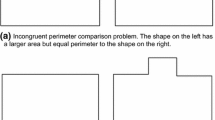Abstract
This study introduces an effective intuitive rule focusing on “tending to the midpoint” in individuals’ mathematical thinking. The rule concerns the intuitive tendency towards choosing the midpoint of a change, as a salient point among all the points. To test the proposed rule, 120 students in grade 9 were interviewed. We analyzed the data using premises from the dual-process theory. Our findings revealed that “tending to the midpoint” is conceivable as an intuitive rule in individuals’ mathematical thinking, and that the answers given to the relevant questions were much affected by the rule consisting of a salient variable as midpoint.

Similar content being viewed by others
References
Babai, R., Brecher, T., Stavy, R., & Tirosh, D. (2006). Intuitive interference in probabilistic reasoning. International Journal of Science and Mathematics Education, 4, 627–639.
Babai, R., Levyadun, T., Stavy, R., & Tirosh, D. (2006). Intuitive rules in science and mathematics: A reaction time study. International Journal of Mathematical Education in Science and Technology, 37(8), 913–924.
Babai, R., Nattiv, L., & Stavy, R. (2016). Comparison of perimeters: Improving students’ performance by increasing the salience of the relevant variable. ZDM - The International Journal on Mathematics Education, 48, 367–378.
Bagni, G.T. (2007). Didactics and history of numerical series, 100 years after Ernesto Cesaro’s death (1906): Guido Grandi, Gottfried Wilhelm Leibnitz and Jacobo Riccati. Retrieved from http://www.syllogismos.it/history/GrandiJointMeeting.pdf.
Barahmand, A. (2017). The boundary between finite and infinite states through the concept of limits of sequences. International Journal of Science and Mathematics Education, 15(3), 569–585.
Ben-Zeev, T. (1998). Rational errors and the mathematical mind. Review of General Psychology, 2(4), 366–383.
Borodin, A. (2016). The need for an application of dual-process theory to mathematics education. CORERJ: Cambridge Open-Review Educational Research e-Journal, 3, 1–31.
De Neys, W., Moyens, E., & Vansteenwegen, D. (2010). Feeling we’re biased: Autonomic arousal and reasoning conflict. Cognitive, Affective, & Behavioral Neuroscience, 10, 208–216.
Evans, J. S. B. T. (2008). Dual-processing accounts of reasoning, judgment, and social cognition. Annual Review of Psychology, 59, 255–278.
Evans, J. S. B. T., & Stanovich, K. E. (2013). Theory and metatheory in the study of dual processing: Reply to comments. Perspectives on Psychological Science, 8(3), 263–271.
Fischbein, E., Tirosh, D., & Melamed, U. (1981). Is it possible to measure the intuitive acceptance of mathematical statements? Educational Studies in Mathematics, 12, 491–512.
Kahneman, D. (2003). Maps of bounded rationality: A perspective on intuitive judgment and choice. In T. Frangsmyr (Ed.), Les prix Nobel: The Nobel prizes 2002 (pp. 449–489). Stockholm, Sweden: The Nobel Foundation.
Landis, J. R., & Koch, G. G. (1977). The measurement of observer agreement for categorical data. Biometrics, 33, 159–174.
Leron, U., & Hazzan, O. (2006). The rationality debate: Application of cognitive psychology to mathematics education. Educational Studies in Mathematics, 62, 105–126.
Leron, U., & Hazzan, O. (2009). Intuitive vs analytical thinking: Four perspectives. Educational Studies in Mathematics, 71, 263–278.
Pearn, C., & Stephens, M. (2007). Whole number knowledge and number lines help develop fraction concepts. In J. Watson & K. Beswick (Eds.), Mathematics: Essential research, essential practice. Proceedings of the 30th annual conference of the Mathematics Education Research Group of Australasia (MERGA), Hobart (Vol. 2, pp. 601–610) Sydney, Australia: MERGA.
Stavy, R., & Babai, R. (2010). Overcoming intuitive interference in mathematics: Insights from behavioral, brain imaging and intervention studies. ZDM - The International Journal on Mathematics Education, 42, 621–633.
Stavy, R., Goel, V., Critchley, H., & Dolan, R. (2006). Intuitive interference in quantitative reasoning. Brain Research, 1073-1074(1), 383–388.
Stavy, R., & Tirosh, D. (1996). Intuitive rules in science and mathematics: The case of ‘more of A -- more of B’. International Journal of Science Education, 18(6), 653–667.
Tirosh, D., & Stavy, R. (1996). Intuitive rules in science and mathematics: The case of ‘Everything can be divided by two’. International Journal of Science Education, 18(6), 669–683.
Tirosh, D., & Stavy, R. (1999). Intuitive rules: A way to explain and predict students’ reasoning. Educational Studies in Mathematics, 38, 51–66.
Tirosh, D., Stavy, R., & Aboulafia, M. (1998). Is it possible to confine the application of the intuitive rule: ‘Subdivision processes can always be repeated’? International Journal of Mathematical Education in Science and Technology, 29(6), 813–825.
Tirosh, D., Stavy, R., & Cohen, S. (1998). Cognitive conflict and intuitive rules. International Journal of Science Education, 20(10), 1257–1269.
Tsamir, P. (2002). The intuitive rule ‘same A-same B’: The case of triangles and quadrilaterals. Focus on Learning Problems in Mathematics, 24(4), 54–70.
Tsamir, P., Tirosh, D., Stavy, R., & Ronen, I. (2001). Intuitive rules: A theory and its implications to mathematics and science teacher education. In H. Behrendt, H. Dahncke, R. Duit, W. Graeber, M. Komorek, & A. Kross (Eds.), Research in science education – past, present, and future (pp. 167–175). Dordrecht, the Netherlands: Kluwer Academic Publishers.
Vamvakoussi, X., Van Dooren, W., & Verschaffel, L. (2013). Educated adults are still affected by intuitions about the effect of arithmetical operations: Evidence from a reaction- time study. Educational Studies in Mathematics, 82, 323–330.
Van Dooren, W., De Bock, D., Weyers, D., & Verschaffel, L. (2004). The predictive power of intuitive rules: A critical analysis of the impact of ‘more A–more B’ and ‘same A–same B’. Educational Studies in Mathematics, 56, 179–207.
Zazkis, R. (1999). Intuitive rules in number theory: Example of ‘the more of A, the more of B’ rule implementation. Educational Studies in Mathematics, 40, 197–209.
Author information
Authors and Affiliations
Corresponding author
Additional information
Publisher’s note
Springer Nature remains neutral with regard to jurisdictional claims in published maps and institutional affiliations.
Rights and permissions
About this article
Cite this article
Barahmand, A. “Tending to the midpoint”: an intuitive rule in mathematical thinking. Educ Stud Math 102, 221–238 (2019). https://doi.org/10.1007/s10649-019-09909-3
Published:
Issue Date:
DOI: https://doi.org/10.1007/s10649-019-09909-3




